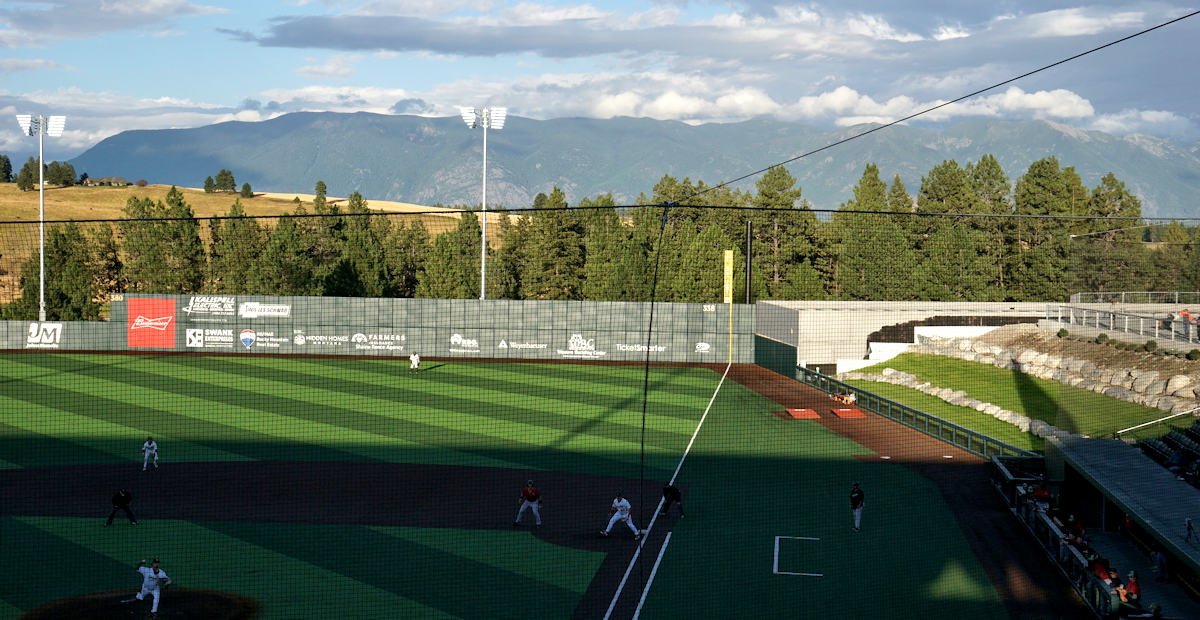
Article and photos by Joe Mock, BaseballParks.com
All rights reserved
KALISPELL, Montana These are interesting times in the Pioneer League.
When Major League Baseball decided to take over the governance of Minor League Baseball, one of their goals was to streamline the operations. One way of doing that was to reduce the number of affiliated teams that the big league clubs had to support. So following the 2020 “non-season” (when no Minor League Baseball was played due to the pandemic), the number of affiliated franchises shrank from 160 to 120. This wiped out entire levels of the Minors, including short-season and rookie ball. Suddenly there was no more Appalachian League, New York Penn League or Pioneer League.
| Ballpark Stats |
 |
| Note: When this was written, the name of the ballpark was Flathead Field. That’s what it’s called throughout this review |
| Award: This park is the winner of our 2023 Ballpark of the Year. See the release announcing it |
| Team: Glacier Range Riders of the indy Pioneer League |
| First game: June 14, 2022, a 9-4 loss to Billings |
| Capacity: 5,500 — 2,250 fixed seats in seating bowl, 200 in suites, rest is general admission |
| Dimensions: LF – 328; LCF – 375; CF – 406; RCF – 380; RF – 338 |
| Architects: A&E Design — Shane Jacobs, Lead Architect |
| Construction: Swank Enterprises |
| Price: Undisclosed (privately financed) |
| Home dugout: 3B side |
| Field points: northeast |
| Elevation: 3,310 feet above sea level |
| Playing surface: SPRINTURF (artificial) |
| Naming rights: none in place during park’s first year. Purchased by Glacier Bank in year 2 |
| Ticket info: ridgerunbaseball.ticketsocket.com/ |
| Betcha didn’t know: This isn’t the first pro baseball team in this area to use Glacier as its geographic designation. The short-lived Glacier Grizzlies played in Whitefish in 2014. |
The affected teams — with the value of their franchises slashed mercilessly — scrambled to find ways to keep playing.
The owners of the teams in the Pioneer League, which dates back to 1939, decided to move forward as an independent professional circuit. They would have to recruit and pay their players for the first time, but with owners, front offices and parks to utilize, they would still offer their communities pro baseball. Most likely in an attempt to ward off lawsuits from the no-longer-affiliated teams, MLB allowed the circuit to call itself an “MLB Partner League.” Apparently, this includes some payments to such leagues from MLB, but only for a few years. After that, they are on their own.
Instead of collapsing, the Pioneer League played the 2021 campaign with eight franchises. “The structure of the league is a strength,” one team’s longtime owner-operator told me. “We didn’t miss a beat. While we’re still learning, we’ve seen attendance go up, not down.”
Meanwhile, Marty Kelly wanted to buy and operate a Minor League club. For the past 18 years, he’s operated the Sunbelt League, a summer-wood-bat circuit in Georgia. He was vetted by Minor League Baseball as an acceptable owner, and he agreed to buy a perpetually troubled franchise in Batavia in the New York Penn League. He even sent a check to Minor League headquarters in St. Petersburg to purchase the team.
And then contraction occurred, and like most of franchises in its league, Batavia no longer had an affiliated club.
Still wanting to buy a team, Kelly spoke with officials in the Pioneer League about purchasing an existing franchise.
His short-term goal was to operate a team successfully in its current market. “I would give it three years,” he told me. “If it wasn’t working, I was going to move it to Flathead Valley. And as part of my contract of purchasing a team, I wanted the right to Flathead Valley.”
Perhaps because the league’s owners still believed their franchises were worth what an affiliated team might fetch on the open market, Kelly was unable to make a deal.
The head of the Pioneer League saw that Kelly knew what he was doing when it came to baseball. According to Kelly, he was told “we want you in the league, with your business acumen (and) your baseball experience.” So in June of 2021, Kelly indicated he’d be willing to start up an expansion franchise in the league somewhere in Montana’s Flathead Valley. But there was a catch: the team had to be ready to play in May of 2022. That’s because the franchise once known as the Orem Owlz was going to be ready to re-join the league in a new park in Northern Colorado, and there had to be an even number of teams for scheduling to make any sense.
“I said ‘No problem. We’ll figure something out. I’m sure there’s a field in the valley we can play in.'” said Kelly.
While Kelly knew the area well having owned a home there for the past two decades, when he started researching possible temporary homes while a permanent stadium was being built, he came up empty. None of the American Legion fields or the community college had an adequate facility.
| The Kelly Family |
 |
| Marty Kelly, shown here in front of one of the paintings by local artist Bradley Chance Hays, and his wife Susan own the Range Riders. They designated their son Chris (below) to oversee the design and construction of Flathead Field. Says Marty of his son, “He has duties from cleaning dishes to having a stadium built.” |
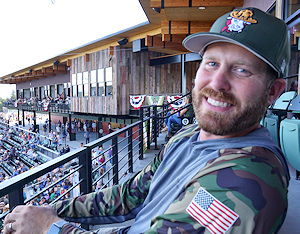 |
Note: since several members of the Kelly family are quoted in this article, I am attaching their first names to each quote, even though that’s not usually acceptable journalistic style. |
He knew there was an abandoned car racing track with some grandstands around it, and its property was for sale. “I thought maybe we could put a baseball diamond in the center of it and have fans sit on those grandstands.” When he went to examine the site, he discovered that there was practically nothing left of the track or the stands, and some houses were being built there. “So I called the real estate agent from there. He said ‘the land you’re probably standing on is for sale, and it’s 40 acres.’ So he came and met us here. We walked it, and I’m like I can’t believe this piece of property is sitting here, and it had just gone on the market.
“So we bought it.”
He added, “I’ve been coming here for 22 years and I’ve watched (the area) grow. I used to tell my kids 20 years ago that one of these days, I’m going to put a Minor League baseball field here near Kalispell.” That dream now had a parcel of land to become a reality.
But there was still a huge problem. By then it was August of 2021, and nothing had been done to start designing the facility, much less construct it.
Marty Kelly’s son Chris had been very involved in the family’s roofing business, and was quite knowledgeable in the areas of construction and project management. The elder Kelly essentially named his son the “owner’s representative” to start assembling a team of professionals to start the process. Those professionals turned out to be Swank Enterprises on the construction, A&E Design on the architecture, and Morrison-Maierle served as the civil engineers. More so than on most stadium projects, the civil engineers “carried a huge load of the project,” said Chris. It is very noteworthy that all of these firms are Montana companies.
“We actually bought the expansion rights (to the franchise) on August 14 and made the announcement on August 16 last year,” recalls Chris. Still with no architectural design in place, “the first crew arrived on-site on September 23. We had a shape and a general idea, and the the site contractor started moving dirt based on that.”
And it wasn’t a small amount of dirt either. And they didn’t have the luxury of time.
Initial estimates suggested that about 100,000 cubic yards of dirt needed to be moved on the site, and because of the way the land sloped, dirt needed to be added and compacted to make for a level outfield. “And all of that had to be done before the first frost or else we couldn’t do it,” Chris explained. “And at that time, there were still no drawings” of the stadium’s design.
When the construction crew started digging, they discovered another speed bump on the road to finishing on time: boulders. Lots and lots of boulders lay at and beneath the surface. Chris estimates that 10,000 of them were moved by the crew. “Some were literally larger than the largest pieces of equipment we had on the site,” he added.
Again, that work was progressing as the facility was being designed.
“We were building the plane while flying it, looking for fuel, about to crash land,” Chris recalls with a grin.
Another element in this crazy story is that the Kellys were determined to create a park that meets the new, more-stringent facility standards that MLB is currently imposing on affiliated ballparks — yet parks in independent leagues aren’t required to do so. Oh, and the design team didn’t have a copy of the final standards.
On top of that, there were severe shortages of construction materials, while prices seemed to rise each day.
Somehow, the excavation, design, engineering and construction came together, and the park was ready to host baseball on its opening day of June 14. No, not every detail was done, but the playing surface, dugouts, seats and everything necessary to host a game were in place.
Says Chris, “Ultimately, we’re very happy with the facility and the way that it turned out.”
The Setting
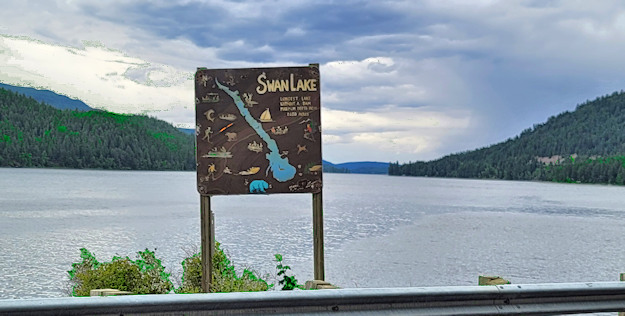
While the obstacles to finishing the ballpark on time were immense, there were a couple of elements that actually worked in the Range Riders’ favor. The biggest is that everything was privately financed. If the Kellys had been seeking public funding — even the smallest amount — the park wouldn’t have been ready for this season. Once city councils and public referendums arrive on the scene, timelines are pushed back by months, if not years.
“In my opinion, it’s not right to ask these communities to pay for these stadiums any more,” says Marty. “I know it happens every day, but I just don’t want to be part of that.”
While the amount spent on the acquisition of the land and the construction has never been made public, the Kelly family did have a budget in mind when construction started. With all of the supply-chain and inflation issues, the final expenditure was higher. Much higher. “It is probably 40% more than what was expected,” said Marty.
Another factor that kept municipal bureaucracy at bay was the fact that the ballpark site isn’t within the city limits of any of the towns in Flathead County. In fact, it couldn’t be more centrally located between the county’s three population centers. It is about three miles north of the city limits of Kalispell (population of about 25,000), three miles south of Whitefish (8,000) and three miles southwest of Columbia Falls (5,000). A lot of homes and vacation properties fall outside of the city limits of these three municipalities. In fact, the overall metro area boasts a population of just over 100,000, certainly large enough to support professional baseball.
The ballpark, by the way, has a Kalispell address, even though it’s not within the city.
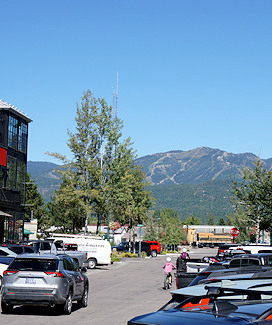 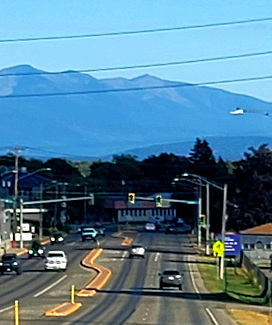 |
The three significant towns in Flathead County all have their own appeal, while (to me) Whitefish has the most charm. There are quaint shops and eateries on its main street, with the ski slopes of Whitefish Mountain (see above left) and stunning Whitefish Lake just to the north. You will definitely want to spend time here.
Whitefish was also once the home to pro baseball — but if you blinked, you missed it. The Glacier Grizzlies played in the indy Mount Rainier Professional Baseball League in 2014 before going defunct. Admit it, you didn’t know there even was a Mount Rainier League. I know I didn’t.
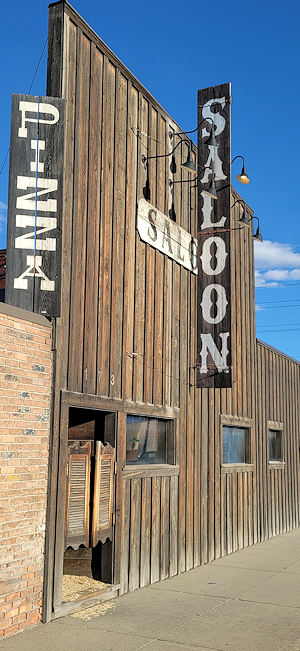 Kalispell (above right, showing the Flathead Range as you drive into town on US Route 93) might not have the quaint feel of Whitefish, but you’ll find the majority of the area’s hotels here, and there are stunning vistas in every direction. Plus there’s a wild-west-themed eatery and bar called The Moose (left) that you won’t want to miss.
Kalispell (above right, showing the Flathead Range as you drive into town on US Route 93) might not have the quaint feel of Whitefish, but you’ll find the majority of the area’s hotels here, and there are stunning vistas in every direction. Plus there’s a wild-west-themed eatery and bar called The Moose (left) that you won’t want to miss.
I have to admit that until this ballpark came along, I’d never had any reason to visit Flathead County, Montana. Boy, failing to visit here was a huge mistake. The mountains and lakes here are as picturesque as anywhere in America. A friend who vacations regularly on the shore of Flathead Lake put it best: God did some of His best work here. I couldn’t agree more.
I hadn’t realized it, but this is a vacation destination for those in the Mountain Time Zone like beaches are in the East. People flock here … meaning flights are crowded, hotels are packed and rental cars are scarce. So if you come for a few days of baseball at Flathead Field, be prepared to pay much more than you might expect.
For example, I spent two nights at the Travelodge in Kalispell. It is a two-star property (personally, I’d give it one star), and it cost me well over $300. I was told by the front desk clerk that just a few weeks earlier, their rate was (gasp) $400 a night. And it’s not even that nice! So be advised.
While camping, hiking, fishing, boating and golf are major activities here (add skiing in the winter), the biggest draw is Glacier National Park. While Yellowstone and Yosemite have more familiar names, they have nothing on the breathtaking majesty of the peaks and valleys within Glacier. While you can drive through the middle of the park on US Route 2 and see sights like you’ve never seen before, the most scenic route is the Going-To-The-Sun Road, which takes you through the heart of the park. However, be smarter than I was: you have to purchase a Park Pass and you must make a reservation to drive on that road a day in advance. And those reservations sell out immediately when they go on sale. I’m really sorry I didn’t know this.
You owe it to yourself and your family to experience this magnificent National Park.
Flathead Field takes its name from the river, lake and county, all called Flathead. The 30-mile-long lake does have sort of a “flat head” on its northern end, although its dam is on the southern end by the small town of Poison. However, that’s not what caused the lake to receive its name. No, this is the country of the Flathead Indian community, although the more-modern name of the tribe is Salish (check out this article to learn what members of the tribe did to make their heads more flat). In fact, much of the lake itself is within the Flathead Indian Reservation, formed by a treaty in 1855. The Native American reservation is the fourth largest in the U.S., encompassing 1,938 square miles.
Flathead Lake is the largest of the numerous finger lakes in this expansive valley, each carved out by advancing and receding glaciers during the Ice Age. If you drive north toward Kalispell from Missoula or Helena on State Route 83, the major lakes you will pass are Salmon Lake, Seeley Lake and Swan Lake (see photo at the top of this section), before driving near the huge Flathead Lake southwest of Kalispell.
With so many deserving towns, lakes, valleys and mountains, why not give the team a geographic designation of something like Flathead or Kalispell? Marty explains that he didn’t want the franchise associated with just one municipality. “The fact that we’re in Flathead county within proximity to all three cities was really special to me,” explains Marty. “But I didn’t want the team to have the stigma of being (called) Kalispell or Whitefish.”
So their decision was to use “Glacier.”
“It’s that regional name that everybody relates to here in Flathead Valley. They are proud of their communities here, and they’re very proud of Glacier (National) Park. It resonates with the community, for sure.”
And after all, the most important thing to Marty was that the ballpark have “location, location, location” right in the middle of the population centers.
Let’s now focus on the property immediately surrounding Flathead Field. During the park’s first season in 2022, it was tricky finding the turn-off from US Route 93 to get to the stadium, as there was no traffic light and not much signage (below left). Google Maps did its job, plus I’d been given a heads up that it is was just north of Kalispell’s horse arena.
 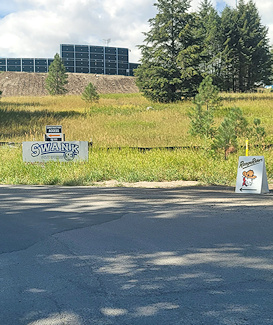 |
The lane off of 93 takes a sharp turn to the left (above right) as you go up the hill to the elevated property on which the ballpark sits. Because the thick trees were left in place, you really don’t spot the ballpark from the highway unless you happen to notice the tops of the light towers.
As work was ongoing throughout the 2022 season, the top of the hill with the ballpark looked like, well, a construction zone, with trailers and heavy equipment being very visible. Note, though, from the west end of the parking lot is a spectacular view of the valley to the southwest. In my opinion, it’s impossible to see too many scenic views. There’s a similar view from the back (facing the parking lot) of the second level of the ballpark.
In the years following 2022, this location will go through a metamorphosis that goes well beyond the completion of Flathead Field. That’s because after purchasing the 40 acres for the ballpark, the Kellys acquired an additional 51 acres between the original 40 and U.S Route 93.
The reason? Development.
For the same reasons that the Atlanta Braves wanted to become developers by creating The Battery adjacent to their new ballpark, the Kellys want to bring a mixed-use development to the land surrounding their ballpark. While no contracts have been signed yet, the vision could include apartments, shops, eateries and other retail businesses, as the suburban sprawl of Kalispell hasn’t quite brought commercial enterprises this far north of the city.
And to the extent that such developing is profitable, “hopefully we can offset the cost” of creating the ballpark, says Chris. He adds that they aren’t just dumping the heavy lifting of the developing (building the structures, attracting tenants, acting as landlords, etc.) to an outside developer. “We are completely part of that.”
Part of this additional development will be a nice, new road to bring folks off of Route 93 up into the development and into the ballpark. The baseball facility is “the anchor of the development,” notes Marty. “Without it, everything else doesn’t get done.”
The 40 acres acquired for the ballpark didn’t come pre-graded for a sports facility. Not even close.
Due to an elevated ridge down the center of the property, “we had a significant amount of grade to consider and some early big decisions that would have a direct impact on the construction complexities, cost and schedule,” recalls Shane Jacobs, Lead Architect at A&E.
According to Jacobs, they considered building up the site so the concourse would be below the seats, or ramping up the level of the stadium as is often done on flat sites, or (the winning idea) do excavation so fans can enter on the concourse level and walk down to their seats.
This is where the 100,000 cubic yards and 10,000 boulders quickly came into the discussion.
But the rolling, boulder-filled site was tamed, and construction of the structures commenced.
One other quick comment about this area. While some parts of the country have bothersome mosquitoes, gnats or flies, the Flathead Valley seems to have a different issue: bees. I don’t mean killer hornets or wasps, but run-of-the-mill honey bees. They swarmed around my car, hung around me in my seat and really loved to be close to the concession items I was trying to enjoy.
“They say it has something to do with the large amount of rain we had earlier this season,” explains Chris.
The Exterior
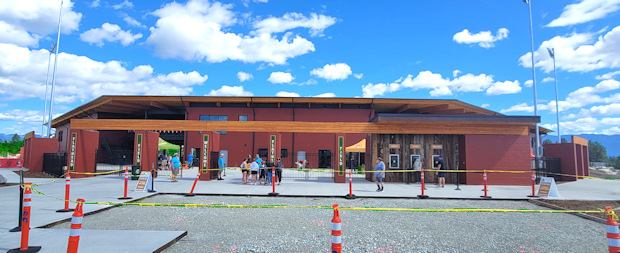
Unlike a Major League or Triple-A ballpark with lots of entryways and fancy masonry, there’s not a whole lot to say about Flathead Field’s exterior.
Perhaps because of the speed that the park had to be built, or because it was designed by an architecture firm doing its first ballpark, the look isn’t at all typical of modern minor league stadiums.
This is not a bad thing.
For years, new minor league parks were often indistinguishable from each other. For example, look at the parks in the Eastern League that are 20 to 35 years old.
But Flathead Field doesn’t look like other parks — in the Pioneer League or elsewhere. “We wanted to make sure that we fit in with the community of northwest Montana and the Western United States,” says Marty. Indeed, the facility’s exterior has the aesthetics of a mountain lodge in the wilds of Montana — so mission accomplished.
What you see from the parking lots is red brick and exposed wood, which is really appealing. “We started design of the complex without a team brand at the time,” says Jacobs. “However, we knew the project and franchise was going to have a connection to Glacier National Park.” That led to selecting building materials from the region. Not only did that make the facility look “local,” it meant the materials would be readily available — a critical aspect of a job with a nearly impossible deadline.
“A modernist design principle is to distill a building down to its essence and I believe we were successful in doing that here, which resulted in an honest pallet of materials that doesn’t try to be something it’s not,” he added.
While much of the outer perimeter of the ballpark is iron fencing, there are distinct structures forming the gates. The main gates and ticket windows are within such a structure directly behind home plate.
Behind third base, there isn’t much to see. However, when the home clubhouse is completed near the left-field foul pole, it will have a number of offseason uses, so staff and patients at the clinic there will most likely enter on this side. Further, there will be a restaurant that is envisioned as a year-round business, and those customers are likely to come and go on this side of the exterior.
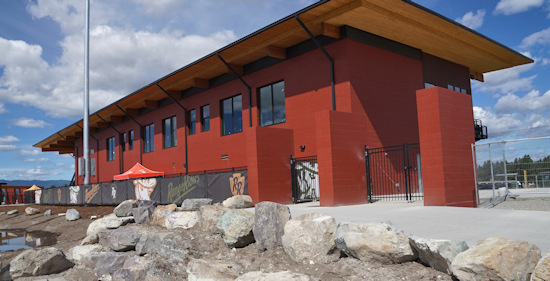
Behind first base (above) is more iron fencing forming the perimeter of the park’s footprint. Just outside this is a small retention pond surrounded by dozens of the boulders unearthed during the excavation of the site. To the right are gates not used for entry, but could allow fans parked on that side of the property to exit after a game.
There is a beautiful layer of tall trees beyond the outfield fences, but typically fans aren’t going to see that side of the exterior. However, you can spot the back of the batter’s eye from the gravel road that leads from Route 93 up to the parking area (as the photo in the previous section indicates).
So despite the mad rush to complete this facility, the exterior accomplishes the goal of looking like it belongs in Montana.
So keep reading as we venture inside to check out the interior of this impressive “plane” that was built while flying it.